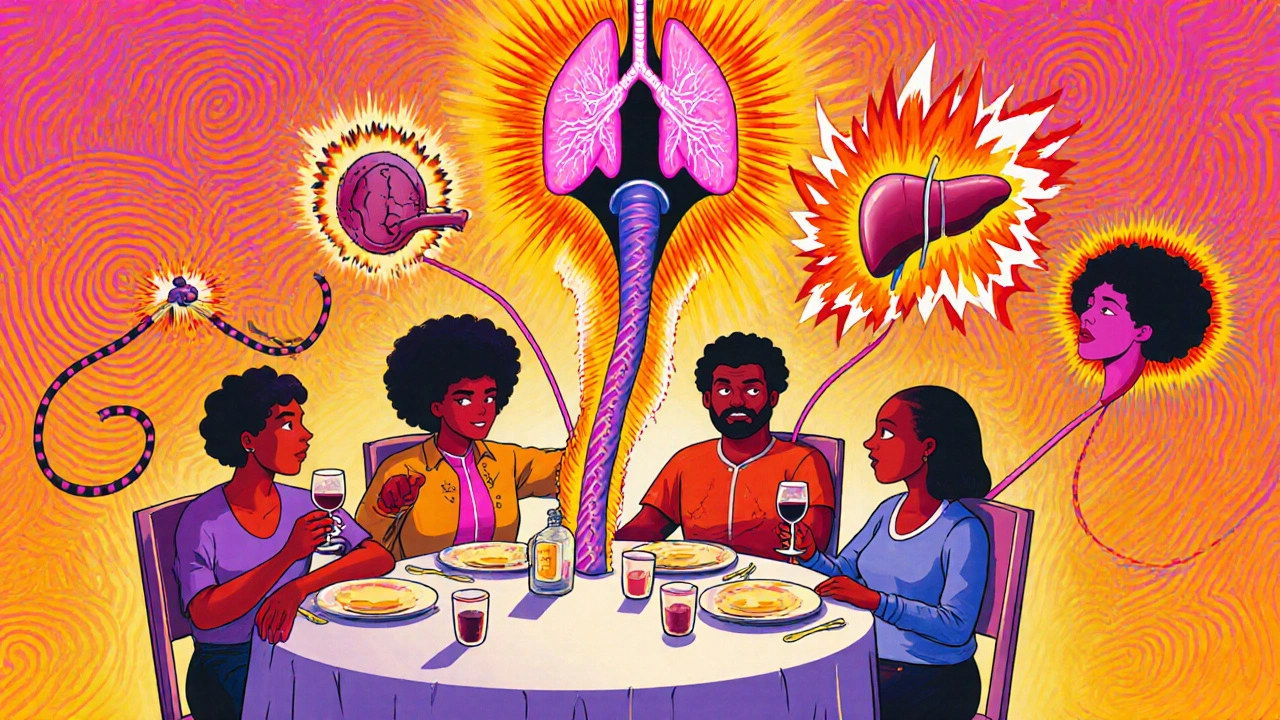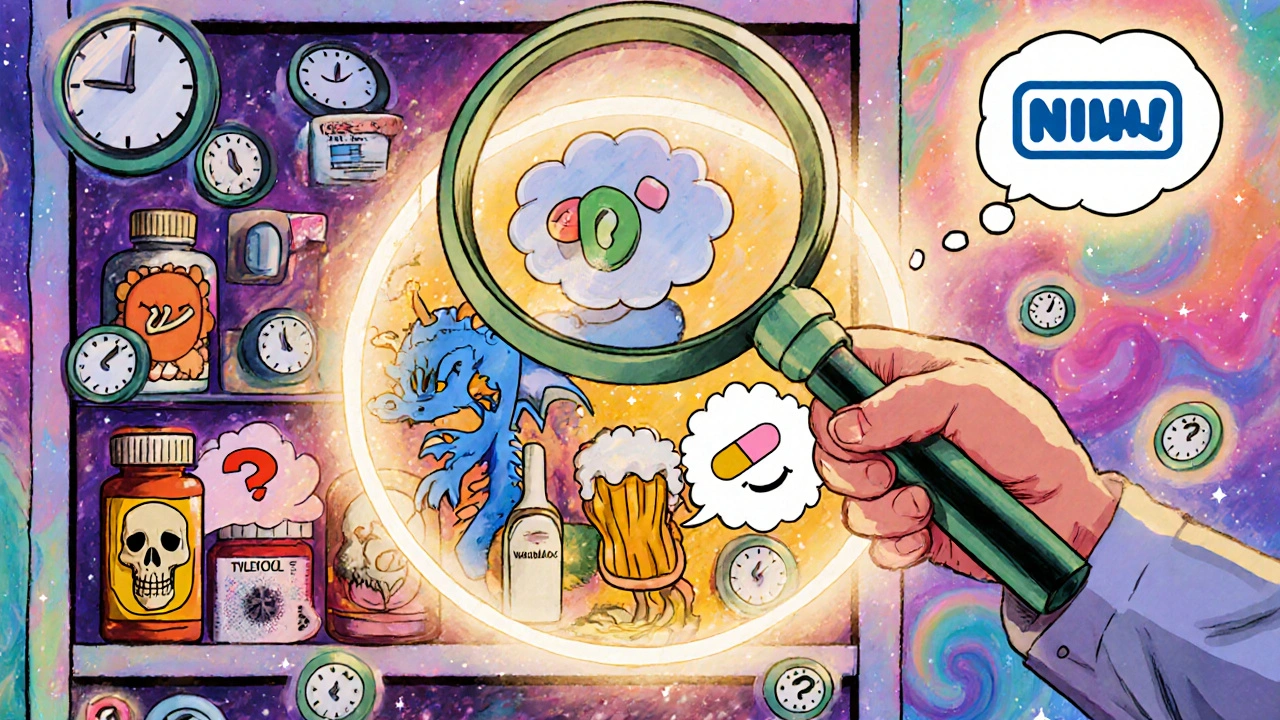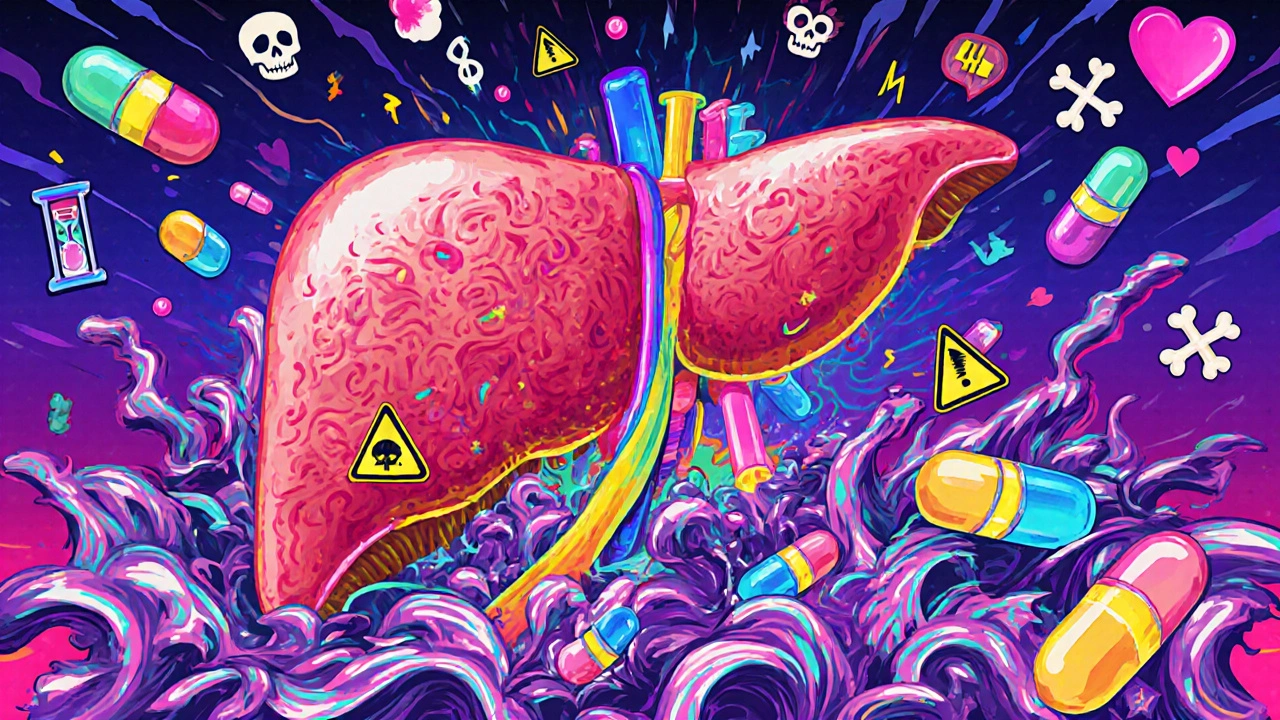More than 40% of adults taking prescription or over-the-counter medications are at risk of dangerous reactions when they drink alcohol. It’s not just about getting drunk faster-it’s about your body struggling to process two substances at once, and the results can be life-threatening. You might think having a glass of wine with your painkiller or a beer after your antibiotic is harmless. But the science says otherwise.
How Alcohol and Medications Fight Inside Your Body
Your liver is the main battlefield. It uses special enzymes-called cytochrome P450-to break down both alcohol and most medications. When you drink, those enzymes get overwhelmed. They start prioritizing alcohol, which means your medication doesn’t get processed the way it should.There are two main ways this goes wrong. First, alcohol can slow down how fast your body clears the drug. That means the medication builds up in your system, turning a normal dose into an overdose. Second, alcohol can make the drug’s effects stronger-especially if it’s something that calms your nervous system, like a sleeping pill or anxiety medication. Together, they can slow your breathing to dangerous levels.
Acute drinking (even one drink) can increase blood levels of some meds by 25% to 75% within an hour. Chronic drinking-having alcohol regularly-does the opposite. It tricks your liver into making more enzymes, which then clears the medication too fast. That means your pill stops working as well as it should.
Medications That Can Kill You With Just One Drink
Some combinations are so dangerous they’re outright banned. These aren’t just warnings-they’re medical emergencies waiting to happen.- Metronidazole (Flagyl) and tinidazole: These antibiotics cause a toxic reaction in 92% of people who drink even one standard drink. Symptoms include flushing, vomiting, rapid heartbeat, and chest pain. You could end up in the ER.
- Disulfiram (Antabuse): This drug is designed to make you sick if you drink. It blocks alcohol breakdown, causing acetaldehyde to flood your system. The result: pounding heart, sweating, nausea, and panic.
- Benzodiazepines (diazepam, alprazolam, lorazepam): These are prescribed for anxiety or sleep. Alcohol multiplies their effect on your brain’s GABA receptors by up to 400%. This combination is responsible for 32% of all alcohol-medication deaths.
- Opioids (morphine, oxycodone, hydrocodone): Alcohol and opioids both depress breathing. Together, they can shut down your lungs. The CDC found this combo increases overdose risk by 8 times.
- Linezolid: This antibiotic can cause a dangerous spike in blood pressure if mixed with alcohol, especially wine or beer.
Hidden Dangers in Your Medicine Cabinet
You don’t need a prescription to be at risk. Many common OTC drugs carry serious warnings you might not see.- Acetaminophen (Tylenol): Taking more than 3 drinks a day while using acetaminophen raises your risk of acute liver failure by 18%. Even one drink a day with regular use can cause liver enzyme spikes in nearly half of users.
- NSAIDs (ibuprofen, naproxen): These painkillers already irritate your stomach lining. Alcohol does the same. Together, they can cause bleeding ulcers. The risk goes up 300% to 500% with regular use.
- Antihistamines (diphenhydramine, doxylamine): Found in sleep aids and cold meds, these cause drowsiness. Add alcohol, and that drowsiness becomes extreme-up to 300% stronger. You could fall asleep while driving or stop breathing in your sleep.
- Antidepressants (SSRIs like fluoxetine): While not usually deadly, alcohol can make you feel more intoxicated, increase side effects like dizziness, and worsen depression over time. One study found it extends alcohol’s effects by over 3 hours.
- Warfarin: This blood thinner becomes unpredictable with alcohol. Too much alcohol can thin your blood too far and cause bleeding. Too little can make it less effective, raising your stroke risk.

Why You’re Not Getting the Full Warning
You’d think your doctor or pharmacist would tell you. But they often don’t. A 2022 survey found 68% of patients were never warned about alcohol risks when they got their prescription. Even on the bottle? Only 42% of prescription labels include a clear alcohol warning, according to an FDA audit.Pharmacists are often the last line of defense. Walgreens data shows that when a pharmacist takes 2 minutes to explain the risk, 89% of patients change their behavior. That’s huge. Yet most pharmacies don’t have systems in place to automatically flag high-risk combinations.
And it’s not just you. Medical schools barely teach this. Only 39% of U.S. medical programs include dedicated training on alcohol-medication interactions. That means doctors are learning on the job-and many don’t know the full scope of the danger.
What You Can Do Right Now
You don’t need to be a scientist to stay safe. Here’s what works:- Ask your pharmacist every time you get a new prescription: “Is it safe to drink alcohol with this?” Don’t assume they’ll tell you unless you ask.
- Know your standard drink: One drink = 12 oz beer (5% alcohol), 5 oz wine (12%), or 1.5 oz spirits (40%). Anything more is a risk.
- Wait 72 hours before drinking if you’re starting metronidazole, tinidazole, or disulfiram. Don’t guess-wait the full 3 days.
- For high-risk meds like benzodiazepines or opioids: Avoid alcohol completely. There’s no safe level.
- For acetaminophen and NSAIDs: Limit alcohol to one drink occasionally, and never on an empty stomach. Eat first. Drink slowly.
- Use the NIAAA’s Alcohol-Medication Interaction Risk Calculator (AMIRC) online. It’s free, easy, and based on your exact meds and drinking habits.
What About “Moderate” Drinking?
The idea that “one drink a day is fine” is misleading. For some people, even one drink with certain meds is too much. Older adults are especially vulnerable. After age 65, liver blood flow drops by 35%. That means alcohol and meds stick around longer, increasing side effects.European guidelines say occasional wine with Tylenol is okay. But American liver specialists point to studies showing even that small amount raises liver enzymes in nearly half of users. The safest choice? Skip it. If you’re on any medication, alcohol isn’t worth the gamble.

Real Stories, Real Consequences
One Reddit user wrote: “I had one beer with my metronidazole. Ended up in the ER with a heart rate of 180 and vomiting. I didn’t know it was that bad.” Another said: “My pharmacist warned me about hydroxyzine and wine. I almost took a glass at my sister’s wedding. She saved me.”These aren’t rare. Drugs.com has over 78,000 user reports of bad reactions. The top offenders? Alprazolam, amitriptyline, and warfarin. Most of these people didn’t think they were doing anything wrong.
What’s Changing Now
New rules are coming. Starting in January 2024, the FDA requires all high-risk medications to include pictograms on labels showing alcohol interaction risks. Telehealth platforms are now adding alcohol screening questions to their intake forms. Medicare Part D plans must flag risky combinations in their systems by December 2024.But until those systems are fully in place, you’re your own best protector. Don’t wait for a warning label. Don’t rely on your doctor to remember. Ask. Check. Protect yourself.
Can I have one drink with my medication?
It depends on the medication. For some, like metronidazole or benzodiazepines, even one drink can cause a life-threatening reaction. For others, like occasional acetaminophen or NSAIDs, one drink with food might be okay-but it’s still risky. The only safe answer is to check with your pharmacist or doctor before drinking.
How long should I wait after taking medicine before drinking alcohol?
For most medications, waiting 2-3 hours after your dose reduces risk slightly, but it doesn’t eliminate it. For high-risk drugs like metronidazole, wait 72 hours. For long-acting drugs like diazepam (which stays in your system for up to 100 hours), you need to avoid alcohol for days-even after your last dose.
Does alcohol make all medications less effective?
No. Alcohol usually makes medications stronger, not weaker. But with long-term drinking, your liver can start breaking down some meds faster, making them less effective. This is common with antidepressants and seizure medications. The result? Your symptoms come back, and you might increase your dose-making the risk even worse.
Can alcohol interact with vitamins and supplements?
Yes. Some supplements like kava, valerian, and melatonin can increase drowsiness when mixed with alcohol. High-dose vitamin A and niacin can harm your liver when combined with alcohol. Even herbal teas like chamomile can add to sedation. Always treat supplements like medications-they can interact too.
I’m older. Should I be more careful?
Absolutely. After age 65, your liver processes alcohol and meds more slowly. You also tend to take more medications. The American Geriatrics Society lists 17 high-risk combinations specifically for older adults. The safest choice? Avoid alcohol entirely if you’re on multiple prescriptions.
What should I do if I already drank and took my medicine?
If you feel dizzy, nauseous, have trouble breathing, or your heart is racing, call emergency services immediately. Don’t wait. If you’re unsure, call Poison Control (1-800-222-1222 in the U.S.) or your local poison center. They can tell you if you need to go to the hospital.


mike tallent
November 18, 2025 AT 11:22Just wanted to say this is one of the clearest, most urgent posts I've seen in a long time. 🙏 I work in pharmacy and see this every single day-people think 'it's just one beer' with their painkillers, and then they end up in the ER with liver damage or respiratory depression. Seriously, if you're on anything, even OTC stuff like Tylenol or Benadryl, just assume alcohol is a co-conspirator. Your liver doesn't care if it's 'moderate.' It just sees two toxins and says 'nope.' Stay safe, folks. 💪
Julie Roe
November 20, 2025 AT 02:58I’m so glad someone finally laid this out without sugarcoating. I’m 68 and on three different meds-warfarin, metformin, and a low-dose benzo for anxiety. My doctor never mentioned alcohol. My pharmacist? She gave me a 3-minute lecture after I asked if red wine was okay with my pills. Turned out, even one glass was a no-go. I used to have wine with dinner every night. Now I have sparkling water with lime. No regrets. Your body doesn’t owe you a drink. And honestly? I feel better without it. If you’re on meds, don’t gamble with your life. Ask. Then ask again. And if they don’t know? Find someone who does.
jalyssa chea
November 21, 2025 AT 12:26Jennifer Howard
November 21, 2025 AT 20:47While I appreciate the intent of this post, it is rife with hyperbolic language and misleading generalizations. The statistic that '40% of adults are at risk' is not substantiated by any peer-reviewed epidemiological study cited here. Moreover, the conflation of acute and chronic alcohol use with medication metabolism is scientifically imprecise. For example, the claim that 'one drink' with metronidazole causes a 92% reaction rate is misleading-it applies to a specific, narrow population under strict clinical conditions. Furthermore, the assertion that 'no safe level' exists for benzodiazepines ignores decades of clinical data on low-dose, supervised use. This post reads less like patient education and more like fear-mongering dressed as public health advocacy.
John Wayne
November 23, 2025 AT 05:41Interesting. All this data, yet no mention of the fact that alcohol is a depressant and has been used medicinally for centuries. The real issue here isn't alcohol-it's the overprescription of CNS depressants. If you're taking benzodiazepines or opioids daily, you've already lost the battle. The system is broken. Alcohol isn't the villain; it's the symptom. Also, I find it amusing that we're now being told to avoid wine with Tylenol, but we're told to drink wine for 'heart health.' Pick a narrative, America.
Peter Stephen .O
November 24, 2025 AT 02:20Y’all need to stop treating alcohol like it’s a snack. 🍷 It’s a psychoactive drug. Full stop. And if you’re popping pills like they’re candy-especially sleep aids, painkillers, or mood stuff-you’re already playing Russian roulette. I’ve seen friends go from ‘just one glass’ to coma in 48 hours because they thought ‘it’s just Tylenol.’ Your liver isn’t a superhero. It’s a tired janitor cleaning up after a rave. And guess who’s gonna get fired? YOU. So next time you reach for a drink with your meds? Pause. Breathe. Ask your pharmacist. Or better yet-skip it. Your future self will high-five you. 🙌
Gary Lam
November 25, 2025 AT 07:06As a guy who grew up in a family where wine was always at dinner, I used to think this was all fear-mongering. Then my uncle died after mixing his blood thinner with a few beers. He didn’t even know the bottle said ‘avoid alcohol.’ So I made a rule: if it’s in a bottle with a prescription label, I don’t touch alcohol. Period. And I tell everyone I know. No shame. No guilt. Just survival. If you’re reading this and you’re on meds? You’re not weak for skipping the drink. You’re smart. And honestly? You’re probably already the coolest person at the party because you’re not the one passed out on the couch.
Abdul Mubeen
November 27, 2025 AT 01:43Let’s be honest: this entire post is a corporate-sponsored scare tactic. The FDA is under pressure to reduce liability, so they’re forcing pharmacists to over-warn. Meanwhile, the pharmaceutical industry profits from both the meds and the ‘alcohol interaction’ panic. Why don’t we talk about why so many people are on benzodiazepines in the first place? Why are we medicating normal human stress? The real danger isn’t alcohol-it’s the system that pushes pills like candy and then blames the drinker when things go wrong. This isn’t education. It’s control.
Joyce Genon
November 28, 2025 AT 07:10Okay, but let’s just acknowledge that this entire article is built on cherry-picked statistics and anecdotal Reddit stories. The 32% death rate from benzodiazepines + alcohol? That’s from a 2017 CDC report that also found 70% of those cases involved polydrug use-heroin, cocaine, you name it. And the ‘18% liver failure risk’ with Tylenol and alcohol? That’s for people drinking 3+ drinks daily for months. Not one glass of wine. Also, why is no one talking about how many people drink alcohol with their meds and never have an issue? Millions. The media loves to sensationalize rare outcomes to sell clicks. Meanwhile, the real public health crisis is opioid overprescribing and lack of mental health access-not whether someone had a glass of chardonnay with their ibuprofen. This post is less about safety and more about moral panic dressed as science.